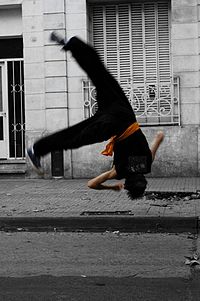Loading AI tools
Group of Chinese martial arts From Wikipedia, the free encyclopedia
Changquan (/tʃɑːŋ.tʃuən/) (simplified Chinese: 长拳; traditional Chinese: 長拳; pinyin: chángquán; lit. 'Long Fist') refers to a family of external (as opposed to internal) martial arts (kung fu) styles from northern China.
This article has multiple issues. Please help improve it or discuss these issues on the talk page. (Learn how and when to remove these messages)
|
 A man doing cekongfan (侧空翻; "side somersault"), a common move in changquan. | |
| Also known as | Long Fist |
|---|---|
| Focus | Striking, weapons training |
| Country of origin | |
| Creator | Zhao Kuangyin |
| Famous practitioners | (see notable practitioners) |
| Parenthood | |
| Descendant arts | Sanshou, Northern Praying Mantis |
| Olympic sport | Wushu (sport) |
The forms of the Long Fist style emphasize fully extended kicks and striking techniques, and by appearance would be considered a long-range fighting system. In some Long Fist styles the motto is that "the best defense is a strong offense," in which case the practitioner launches a preemptive attack so aggressive that it deprives the opponent of the opportunity to attack. Others emphasize defense over offense, noting that nearly all techniques in Long Fist forms are counters to attacks. Long Fist uses large, extended, circular movements to improve overall body mobility in the muscles, tendons, and joints. Advanced Long Fist techniques include qin na joint-locking techniques and shuai jiao throws and takedowns.[1]
The Long Fist style is considered to contain a good balance of hand and foot techniques, but in particular it is renowned for its impressive acrobatic kicks.[2] In demonstration events, Long Fist techniques are most popular and memorable for their whirling, running, leaping, and acrobatics. Contemporary changquan moves are difficult to perform, requiring great flexibility and athleticism comparable to that of gymnastics.
Long Fist's arsenal of kicks covers everything from a basic front snap-kick to a jumping back-kick, from a low sweep to a whirlwind-kick. Specifically, typical difficulty movements in modern changquan include the whirlwind kick, the butterfly kick, the cekongfan (侧空翻; 'side somersault'), and the lotus kick.
The core of changquan is attributed to the 10th century Emperor Taizu, the founding emperor of the Song dynasty. His style was allegedly called taizu changquan, which means "the Long Fist style of Emperor Taizu."[3] That said, these texts can only be reliably dated to the second half of the 19th century. The Long Fist of contemporary wǔshù draws on Chaquan, "flower fist" Huāquán, Pao Chui, and "red fist" (Hongquan).
Widely perceived to have a strong Shaolin influence, traditional Long Fist was promoted at the Nanjing Guoshu Institute by Han Qing-Tang (韓慶堂), a famous Long Fist and qin na expert.[4] After the defeat of Chiang Kai-shek and subsequent closing of the institute, the new People's Republic of China created contemporary wushu, a popular artistic sport inspired largely by traditional Long Fist. However, this new evolution of changquan differed from the old style in that it was exhibition-focused. Higher, more elaborate jump kicks and lower stances were adopted, in order to create more aesthetically pleasing forms. Applications were then reserved for the sport of sanshou, which was kept somewhat separate from the taolu (forms). In 2005 with the creation of difficulty movements criteria in international competition, there has been a continued attention to jumps.
Northern Shaolin Long Fist Kung Fu Includes:
Seamless Wikipedia browsing. On steroids.
Every time you click a link to Wikipedia, Wiktionary or Wikiquote in your browser's search results, it will show the modern Wikiwand interface.
Wikiwand extension is a five stars, simple, with minimum permission required to keep your browsing private, safe and transparent.